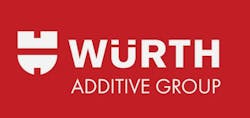Behold the possibilities of forming anything from nothing. Additive manufacturing, the process of spraying melted powdered plastics or metal onto a sheet—layer by layer—until the item materializes, is a technology that has spanned decades.
What makes a remarkable difference today with on-demand parts produced by additive manufacturing, also called 3D printing, is its expediency in the marketplace. Broken supply chains and costly retooling for scarce items have given Würth Additive Group an opening to fill the short-run production gap with various industrial machine options. Given its sophistication, the end-user should not distinguish any quality deviation from the original copy.
Originally, Würth Additive Group began using the process to produce fasteners, fittings and other engineered parts for automakers and original equipment suppliers.
Then in the past few years, the collision repair industry demonstrated an unmet need, in which Würth's CEO, A.J. Strandquist, took up the cause for 3D printing by pushing for authorized service providers.
Strandquist, who addressed a Collision Industry Conference audience in July, alleged that some independent operators are creating OEM duplicate parts without the vehicle manufacturer's validation, which might pose a risk to the consumer, notably component failure, wrote Repairer Driven News. To keep up with the industry specifications for mechanically sound parts, he urged the industry to side with a certified supplier network that can reproduce "OEM-approved" quality. Würth estimates that a body shop will need to rely on a 3D printer provider for at least 15 percent of its inventory, the trade publication reported.
3D printing seen as a solution for backordered parts
"Where we see 3D printing fitting into the supply chain is when the supplier’s materials are on backorder," said Carter Rhodes, sales engineer for the global organization whose interests lie in the transportation segment. Rhodes added, "if somebody needs to have that product sooner, they might pay a little more, but the time savings is going to be greater."
Some of Rhodes’ responsibilities involve advising the commercial manufacturer client on establishing economical product solutions for their customers who often service the body shop. Typical situations may bring about ways to avoid paying for expensive components because a replacement piece cannot be located. "Say you're in an accident with a slightly damaged headlight assembly. Instead of scrapping the $500 unit, it would be more efficient to reprint the three-dollar clip and reuse the headlamp," Rhodes said.
Even though Würth never set out to become a manufacturer, it has multiple partnerships with other companies that can step into that role to solve production capacity restrictions. Brands like Arburg, DSM, and Baker Hughes are anything but commoditized as each one delivers a specific functionality without overlap. These resources can formulate parts for a variety of applications, from prototyping to tooling and production.
Meanwhile, at the turn of 2020, Würth sought other firms that could churn out orders when it would be unfeasible for an account to buy a costly industrial-grade machine. One such partner, Re3DTech, customizes jobs for several industries, including the automotive aftermarket, which frequently requires a broad application of composites to blend metal materials.
“As a service, we will funnel requests through them as a partner. They have been printing parts for a number of companies,” said Rhodes, who emphasized that Würth has built its reputation on streamlining inefficient logistical practices on behalf of its business customers. “We do a lot of education on 3D printing. We tend to be more on the side of placing printers in manufacturers and helping them get that started and integrating that into the process.”
But Rhodes notes a practical limit to how far these technologies can go with one-off, high-end, complex jobs. The day when mass production output flanked with a bank of printers displaces the traditional factory space is far away. Rhodes says that the speed and cost of injection molding are hard to compete at that scale when someone demands bulk output.
A licensing rights hurdle facing not only Würth but also the additive industry is in convincing the OEMs to release the digital files, the data that contains the specific imagery, to anyone wanting to print a replica. Without an accessible digitized blueprint, explains Rhodes, obtaining an exact fitment for a legacy item presents an unclear path forward. Especially concerning replacement crash parts, the installer must guarantee that its shape must align, perform, and last as long as the original. Otherwise, an inexact match poses a safety and legal challenge. “All of these things must have certifications, especially if it is a critical part. It becomes a difficult space because we don't want the liability if something does go wrong and causes an accident,” Rhodes said.
Automotive application hard parts in many respects are an open-ended frontier for convenient manufacturing, contends Rhodes. Despite decades of growth from the original liquified resin cured by ultraviolet light, the comingling of metals with plastics remains a work in progress, in Rhodes’ opinion. Fast selling categories like suspension, chassis, or braking systems can be printed, but at a disproportionality steeper price, unlike the cost-efficient injection plastic molding used to form bumpers or interior accessories. He is optimistic, though, that one day layering metals with non-metals will become commercialized at a reasonable price point.
Overall, in the scheme of this customized trade, Rhodes believes that additive technology will open up multiple benefits that traditional fabrication cannot. "So if it's like a tool for a specific job but only done once a year, it probably will not make sense to make that tool to be machined or by some other fabrication method. 3D printing…why not?"


